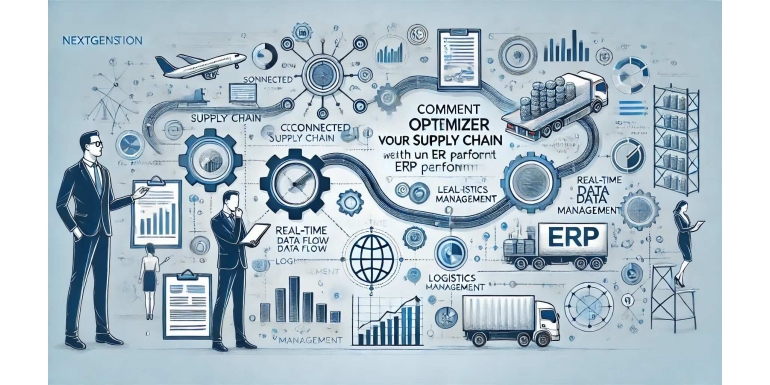
How to Optimize Your Supply Chain with a High-Performance ERP
Supply chain management is at the heart of competitiveness in modern businesses. In an era where speed, efficiency, and transparency are paramount, having a high-performance Enterprise Resource Planning (ERP) system has become an indispensable asset for any company looking to optimize its supply chain. This article explores the various ways a high-performance ERP can transform supply chain management by offering solutions to streamline processes, improve visibility, and enhance responsiveness.
1. What is an ERP and Why is it Crucial for the Supply Chain?
An ERP (Enterprise Resource Planning) is an integrated software system that centralizes management information across different functions of a company, such as accounting, human resources, production, and, of course, supply chain management. A high-performance ERP allows these different functions to share real-time information, automate key processes, and make decisions based on reliable data.
-
Data Centralization: An ERP integrates all supply chain information into a single system, making it easier to access critical data and ensuring consistency and accuracy.
-
Process Automation: By automating repetitive tasks such as inventory management, invoicing, or order processing, an ERP frees up time to focus on higher value-added activities.
-
Improved Collaboration: An ERP fosters collaboration between different departments by providing shared access to information, reducing silos, and enhancing communication.
2. How Can a High-Performance ERP Improve Inventory Management?
Inventory management is a crucial aspect of the supply chain. Poor management can lead to costly stockouts or overstocking, which unnecessarily ties up capital. A high-performance ERP offers powerful tools to optimize inventory management.
-
Real-Time Visibility: An ERP allows you to track inventory levels in real-time, providing complete visibility into available quantities, ongoing orders, and future needs.
-
Accurate Forecasting: With advanced algorithms, an ERP can analyze sales trends and forecast future demand, enabling proactive inventory adjustments and preventing stockouts.
-
Automated Replenishment Management: An ERP can automate the replenishment process by automatically placing orders when inventory levels reach a predefined threshold, ensuring a continuous flow of goods.
3. Enhancing Production Planning with an ERP
Production planning is a complex task that requires close coordination between multiple departments. A high-performance ERP offers advanced planning features that facilitate the synchronization of operations.
-
Demand-Based Planning: An ERP allows production to be planned based on sales forecasts and current orders, optimizing resource utilization and reducing production lead times.
-
Real-Time Production Tracking: ERP systems provide real-time updates on the status of production, allowing managers to monitor progress and take corrective actions if necessary.
-
Resource Management: An ERP enables efficient management of the material and human resources needed for production, optimizing resource allocation and reducing downtime.
4. Optimizing Logistics and Distribution with an ERP
Logistics and distribution are essential links in the supply chain. A high-performance ERP offers tools to optimize these processes, reducing costs and improving customer satisfaction.
-
Optimized Delivery Routes: An ERP can optimize delivery routes based on various factors such as distance, traffic, and delivery priorities, reducing transportation costs and delivery times.
-
Shipment Tracking: ERP systems allow real-time tracking of shipments, providing full visibility into the movement of goods and enabling proactive management of delays or issues.
-
Return Management: An ERP facilitates return management by automating the return process and tracking the status of returned goods, improving customer satisfaction and reducing associated costs.
5. Reducing Costs and Increasing Efficiency with an ERP
Supply chain optimization involves reducing costs and improving operational efficiency. A high-performance ERP offers solutions to achieve these goals.
-
Reduced Operational Costs: By automating processes and reducing human errors, an ERP helps lower operational costs and improve overall efficiency.
-
Optimized Supplier Management: An ERP enables efficient management of supplier relationships by tracking performance, negotiating contracts, and optimizing purchasing conditions, thereby reducing procurement costs.
-
Improved Decision-Making: With customizable dashboards and reports, an ERP provides actionable insights that enable informed decision-making, optimizing supply chain management.
6. Ensuring Compliance and Traceability with an ERP
Traceability and regulatory compliance are critical aspects of the supply chain, especially in sectors such as food, pharmaceuticals, and aerospace. A high-performance ERP helps meet these requirements effectively.
-
Product Traceability: An ERP allows tracking of each product batch from raw materials to the finished product, ensuring complete traceability in case of product recalls or quality control.
-
Regulatory Compliance: ERPs offer features to track and manage compliance with local and international regulations, reducing the risk of penalties and reputational damage.
-
Audit Management: An ERP facilitates the preparation and management of internal and external audits by centralizing necessary documents and automating verification processes.
Conclusion: ERP, an Indispensable Tool for an Optimized Supply Chain
Optimizing the supply chain is essential to remain competitive in a globalized market. A high-performance ERP is an invaluable asset that allows for data centralization, process automation, improved visibility, and cost reduction. By adopting an ERP tailored to your needs, you can transform your supply chain into a performance engine capable of meeting current and future challenges. To get the most out of your ERP, it is crucial to plan its implementation carefully, taking into account your company’s specificities and the goals you want to achieve.
